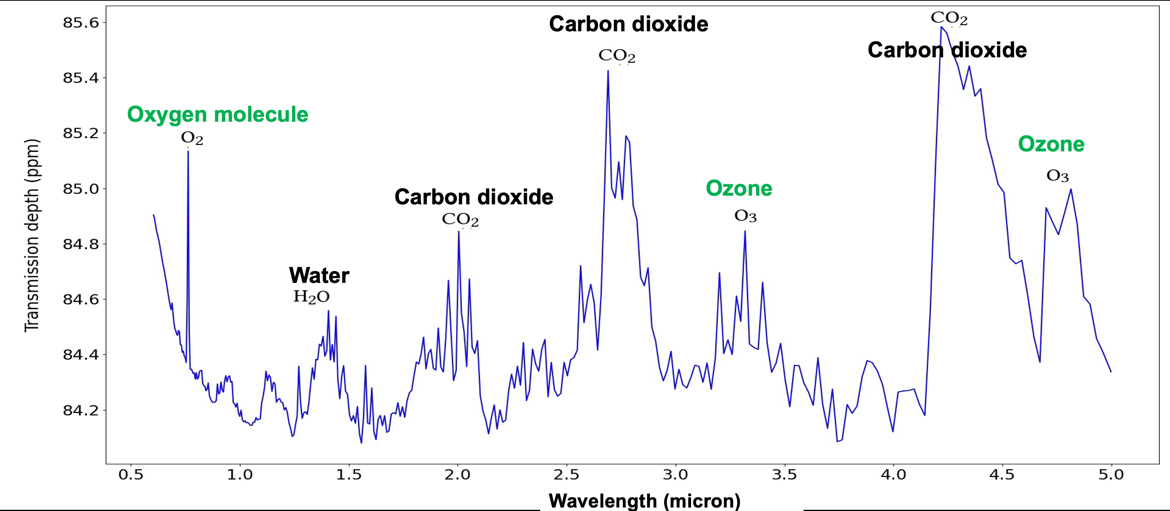Scientists have presented detailed numerical models of the spectrum of an Earth-like exoplanet carrying bio-signature such as oxygen and ozone molecules along with water molecules. The study may help in identifying inhabited exo-planets in the near future when big-budget missions like James Webb Space Telescope (JWST) (already operational), Roman Space Telescope, Habitable Exoplanet Observatory (HabEx), Large UV/Optical/IR Surveyor (LUVOIR), Thirty Meter Telescope (TMT), Extremely Large Telescope (ELT), and so on have the capacity to obtain the transmission spectra, phase-dependent albedo and polarization of rocky planets in the habitable zone of Sun-like stars.
Since the Nobel prize-winning discovery of the first exoplanet, 51 Pegasi b, in 1995, more than five thousand planets orbiting stars other than the Sun have been discovered through various astronomical methods by using several ground- as well as space-bound telescopes. These discoveries not only revolutionized our knowledge and understanding of the vast number and varieties of worlds beyond our own world, the Solar system but also have rekindled the eternal curiosity of mankind – “Is anybody out there?” Many rocky extra-solar planets or exoplanets have been discovered with appropriate temperatures for water to exist in a liquid state at their surface. They are termed as habitable planets and considered to be potential candidates to harbor life. However, all rocky planets with favorable temperatures for life may not necessarily host life. While techno-signature in the form of coded signals through radio waves can imply the presence of extra-terrestrial intelligent life, evidence for the presence of an Earth-like atmosphere with bio-signature as the proof for biological activities in any exoplanet can also answer the question --- “Are we alone?”
Recently, a group of scientists at the Indian Institute of Astrophysics (IIA), Bangalore, an autonomous institute of the Department of Science and Technology (DST), Government of India, have presented a quantitative analysis and estimation of all the known physical properties of an Earth-size rocky exoplanet in the habitable zone of its parent star that can serve to identify any inhabited exoplanet.
Dr. Sujan Sengupta, a professor of IIA, and his Ph.D. student Ms. Manika Singla along with Dr. Aritra Chakrabarty, who completed his Ph.D. thesis work at IIA under the supervision of Prof. Sengupta and currently a postdoctoral fellow at Chile presented detail numerical models of the spectrum of an Earth-like exoplanet carrying bio-signature such as oxygen and ozone molecules along with water molecules. They also demonstrated the effect of scattering by cloud, if present, on the spectra, known as transmission spectra which can be obtained by passing the starlight before and during the planetary transit across the star through an instrument called spectrograph attached to a telescope.
The group also estimated and presented the reflectivity or albedo and polarization due to scattering by atmospheric atoms and molecules at different orbital phases of the planet such that it can be identified as a true twin of the Earth. The research paper has been published in The Astrophysical Journal.

Figure 1. Transmission spectrum showing bio-signature (in green) of an Earth-like exoplanet.

Figure 2. Albedo and polarization of an Earth-like exoplanet at various orbital phase angles. Positions of the planet at mid-transit with the night side facing the observer and at the secondary eclipse with the day side facing the observer are shown (not to scale). Polarization become zero at these two positions due to symmetry in the illuminated planetary disk. Polarization is maximum at half-phase.






























